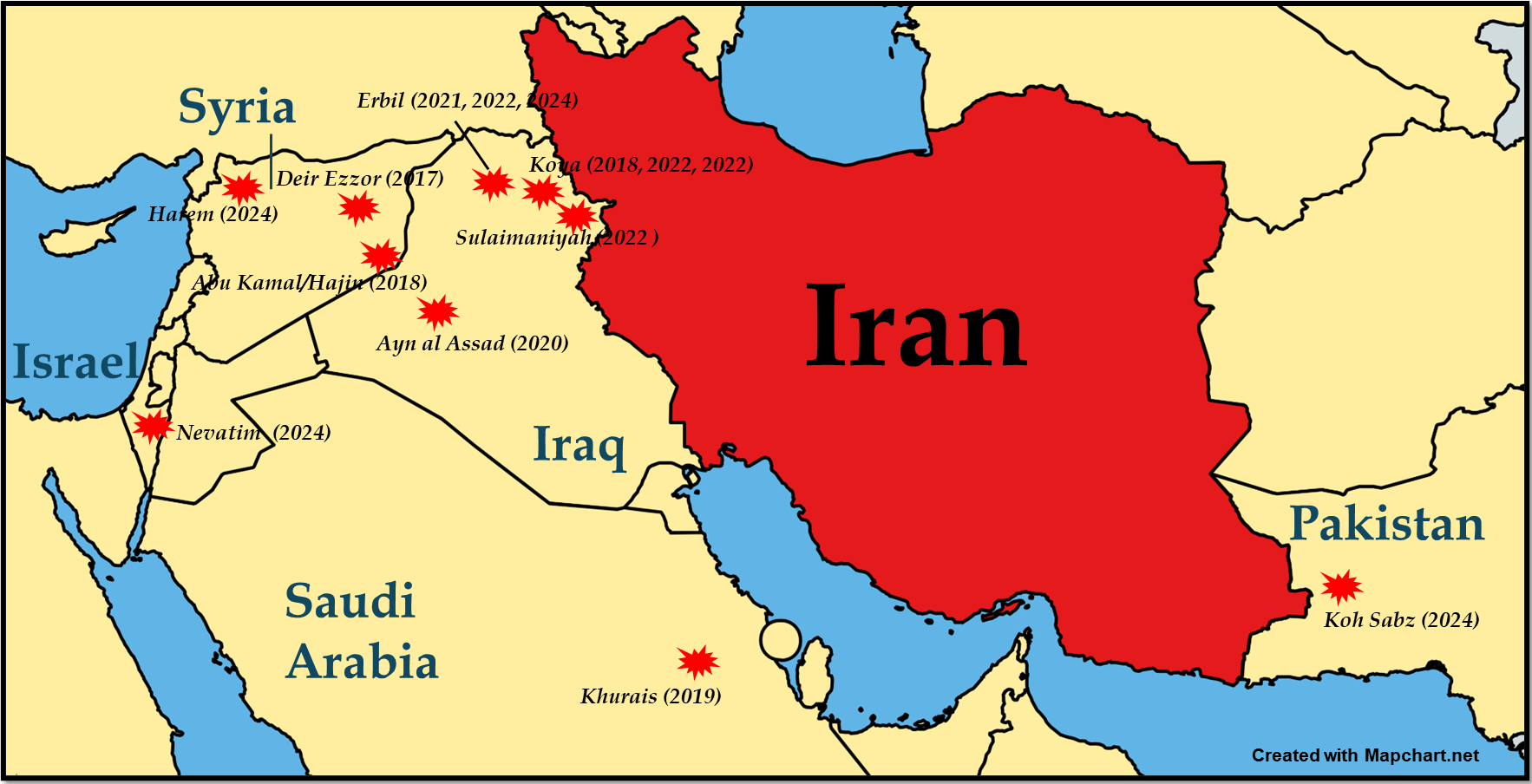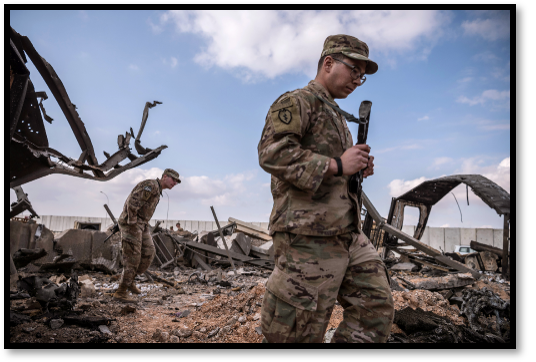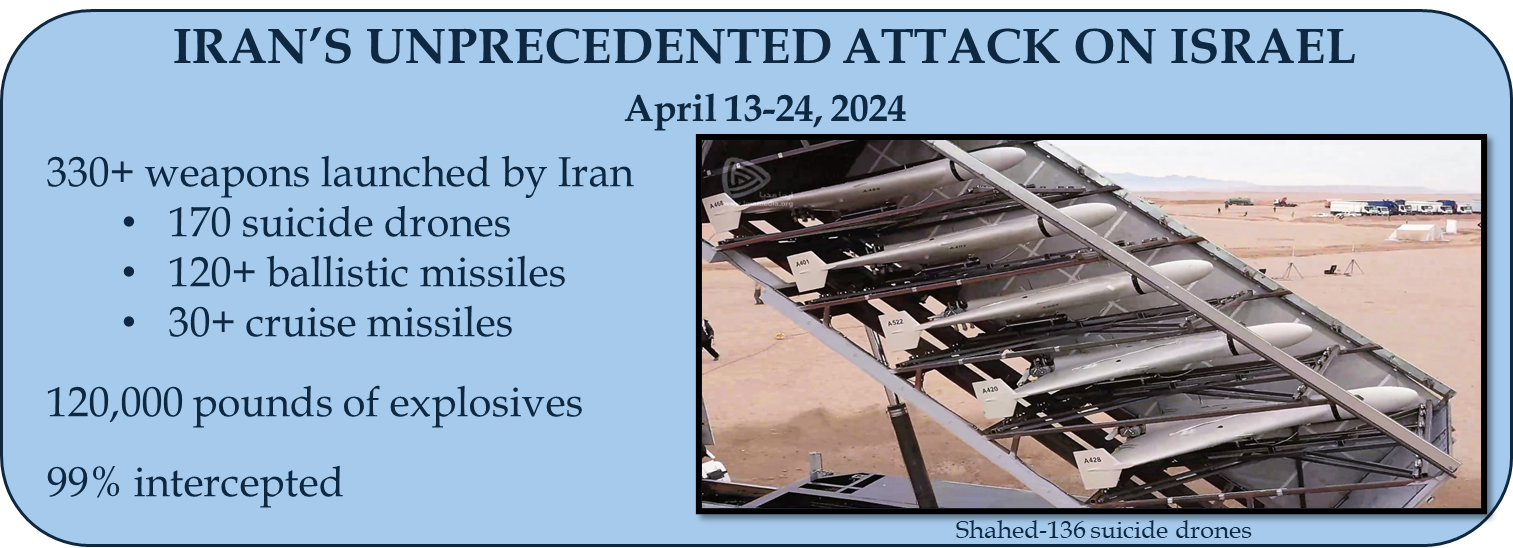Iran’s missile program, which dates back to the monarchy, has been an increasingly important military staple since the 1979 revolution, as the Islamic Republic’s warplanes became obsolete. In the mid-1980s, Tehran acquired Scud missiles from Libya, Syria and North Korea and also began adapting the technology for their missile variants. Since the late 1980s, Iran has developed an increasingly sophisticated arsenal of missiles—with growing range and accuracy—that became critical to its offensive capabilities as well as its strategy of defensive deterrence. Iran has launched missiles in three major stages over the past four decades.
- First: In the 1980s, Tehran deployed missiles during the eight-year war with Iraq, when President Saddam Hussein launched the “war of the cities” and missiles penetrated deep into Iran. Tehran countered primarily with Scud B missiles, which have a range of 300 km (185 miles). It fired on Iraqi cities such as Baghdad and oil-rich Kirkuk in the north.
- Second: Between 1994 and 2001, Iran fired the Shahab-1, its own variant of the Scud B, with a range of 300 km (185 miles), at bases in Iraq used by the Mujahedin-e Khalq, an opposition group linked to underground operations across the border. Tehran did not fire missiles for the next 16 years, but it continued to develop and test short-range and medium-range ballistic missiles.

- Third: Since 2017, Iran demonstrated new missile capabilities. In 2017 and 2018, it fired a dozen short-range ballistic missiles, mainly Zolfaghars with a range of 700 km (440 miles), on ISIS targets in eastern Syria; some traveled more than 370 miles, crossing over Iraq. In 2018, it launched seven short-range ballistic missiles, Fateh-110s with a range of 300 km (185 miles), at Kurdish separatists based in northern Iraq. In 2019, Iran allegedly fired seven cruise missiles at a Saudi Arabian oil facility. But the type of missile used, and its range were unclear. And in 2020, Iran fired more than a dozen short-range ballistic missiles—including Zolfaghars and potentially Fateh-313s with a range of 500 km (310 miles), and Qiams with a range of 700 to 800 km (440 to 500 miles) – at two Iraqi military bases housing U.S. troops. In 2024, Iran demonstrated the range of its new generation of missiles when it attacked Islamic State targets in northwest Syria and launched an unprecedented assault on Israel using ballistic missiles as well as cruise missiles and drones.
Related Material:
- Iran's Missiles: Evolution and Arsenal
- Iran's Missiles: Military Strategy
- Iran's Missiles: Infographics and Photos
- Iran's Missiles: Transfer to Proxies
Major Attacks Since 2017
June 18, 2017: Eastern Syria
The Revolutionary Guards launched five to six Zolfaghars, solid-fueled missiles with a range of some 700 km (430 miles), at an ISIS command center and an assembly site for car bombs in Deir Ezzor province in eastern Syria. They may have also launched one Qiam-1, a liquid-fueled missile with a range of 700 to 800 km (440 to 500 miles). “A large number of terrorists have been killed and their equipment, systems and weapons have been destroyed,” the Guards reported. The short-range ballistic missiles, launched from trucks, traveled more than 600 km (370 miles) from Iran’s western provinces of Kermanshah and Kurdistan. The operation was in retaliation for twin ISIS attacks on Iran’s parliament and the shrine of late revolutionary leader Ayatollah Ruhollah Khomeini on June 7, 2017.
September 8, 2018: Iraqi Kurdistan
The Revolutionary Guards fired seven Fateh-110s, solid-fueled missiles with a range of 300 km (185 miles), at Iranian Kurdish dissidents based in Iraq. The short-range ballistic missiles reportedly hit the headquarters of the Kurdistan Democratic Party–Iran (KDP-I) and the Democratic Party of Iranian Kurdistan (PDKI) in the town of Koya, in Iraq’s Kurdistan region. At least 11 people were reportedly killed and dozens were wounded, including the KDP-I’s secretary-general. Fateh missiles are solid-fueled missiles that can be launched from trucks.
The operation followed new clashes between Iranian border guards and Kurdish dissidents. KDP-I and PDKI militant seek greater autonomy for the Kurdish minority in Iran. Since at least the 2000s, Kurdish opposition groups have sporadically attacked Iranian soldiers from across the border. “The punishment of transgressors was planned following the recent months’ wicked acts by terrorists from the Kurdistan realm against the Islamic Republic’s borders,” the Revolutionary Guards said.
October 1, 2018: Eastern Syria
The Revolutionary Guards fired six short-range ballistic missiles at ISIS targets in the Abu Kamal and Hajin regions of eastern Syria, near the Iraqi border. Iranian media reported that the missiles included Zolfaghars and up to two Qiam-1s. The Zolfaghar is solid-fueled missile with a range of some 700 km (430 miles). The Qiam-1 is liquid-fueled missile with a range of 700 to 800 km (440 miles to 500 miles). Iran claimed that some 40 ISIS leaders were killed.
The operation was retaliation for an attack on a military parade in the Iranian city of Ahvaz on September 22, 2018. “Terrorists used bullets in Ahvaz,” Revolutionary Guards Gen. Amir Ali Hajizadeh, told Tasnim news agency. “We answered them with missiles.”
September 14, 2019: Eastern Saudi Arabia
Yemen’s Houthi rebels, which have allegedly received weapons from Iran, claimed responsibility for twin attacks on Saudi Arabian oil facilities at Abqaiq and Khurais. But Washington and Riyadh blamed Tehran. Iran reportedly launched 18 drones and seven cruise missiles from its Ahvaz Air Base in southwest Iran, about 400 miles north of the Saudi facilities. Four out of the seven missiles reached the Khurais facility. The attacks temporarily disrupted production of 1.2 million barrels per Khurais and 4.5 million barrels per day at Abqaiq, about half of Saudi Arabia’s total crude oil output.
The facilities were hit by the Ya Ali, an Iranian medium-range cruise missile with a maximum range of 700 km (435 miles), Saudi Arabia said. After an international investigation, U.N. experts said the missiles were “largely identical” to the Quds-1, a land-attack cruise missile with a similar range. The attack would mark the first time Iran had used the Quds-1 cruise missile, which had previously been used only by the Houthis in attacks on Saudi Arabia.
January 8, 2020: Western Iraq, Iraqi Kurdistan

The Revolutionary Guards launched 15 to 22 short-range ballistic missiles at Ayn al Asad and Erbil Air Bases in Iraq, which also housed U.S. soldiers. The attack reportedly involved two or more types of missiles, including the Zolfaghar, a solid-fueled missile with a range of some 700 km (430 miles). The Fateh-313, a solid-fueled missile with a range of 500 km (310 miles), and the Qiam-1, a liquid-fueled missile with a range of 700 to 800 km (440 miles to 500 miles) also may have been fired but did not necessarily reach the bases. Some experts speculated Iran may have used Qiam-2s, which have a maximum range of 800 km (500 miles). More than 100 U.S. service members were diagnosed with traumatic brain injuries after the attack, and several structures at Ayn al Asad were damaged or destroyed. The missiles “were intended to cause structural damage, destroy vehicles and equipment and aircraft, and to kill personnel,” said Mark A. Milley, chairman of the Joint Chiefs of Staff.
The attack was retaliation for the U.S. killing of Iranian Gen. Qassem Soleimani, the head of Iran’s elite Qods Force, on January 3, 2020. The U.S. drone attack on a convoy as it left Baghdad International Airport killed seven people, including Abu Mahdi al Muhandis, the leader of Kataib Hezbollah, an Iraqi militia trained and armed by Iran that had attacked U.S.-led coalition forces and Iraqi Security Forces. Washington alleged that Soleimani was planning new attacks targeting U.S. personnel and interests in the region.
March 13, 2022: Western Iraq, Iraqi Kurdistan
The Revolutionary Guards launched at least 10 Fateh-110 missiles into neighboring Iraq early in the day. They claimed to have targeted Israeli “strategic centers” in the northern city of Erbil, the capital of the autonomous Kurdish region. Iraqi and U.S. officials said that the attack was unjustified.
One civilian was injured, according to Kurdish authorities. At least four missiles hit a villa owned by Baz Karim Barzinji, the CEO and founder of oil company KAR Group. The offices of local television network K24 and some houses were also damaged.
Iraqi officials condemned the attack as a violation of their country’s sovereignty. But they stopped short of calling out Iran, the most influential foreign player in the country. Masrour Barzani, the prime minister of the Kurdistan Region, called the strike a “cowardly” act of terrorism. In a call with Secretary of State Antony Blinken, Barzani “stressed the urgent need to counter the fabricated set of false narratives used repeatedly in recent years in attacks on Erbil.”
Iran characterized its moves as defensive. “Several times in the past, Iraq’s territory was used against Iran by third parties including terrorist groups such as Kurdish militants, the United States and the Zionist entity (of Israel),” Foreign Ministry Spokesperson Saeed Khatibzadeh said on March 14. “The Islamic Republic of Iran expects Iraq’s central government that it will end this situation once and for all,” he added. The Revolutionary Guards said that the attack was retaliation for an alleged Israeli strike in Syria on March 7. Iran claimed that four people, including two Revolutionary Guards colonels, were killed near Damascus.
Sept. 28, 2022: Western Iraq, Iraqi Kurdistan
The Revolutionary Guards launched 73 ballistic missiles and at least 20 drones on 42 targets in Iraq’s semi-autonomous Kurdish area. The strikes were concentrated around Koya but spread across a 250-mile-wide area. The Revolutionary Guards targeted Kurdish separatist groups, which Tehran blamed for fueling widespread protests sparked by the death of Mahsa Amini, a young Kurdish woman detained for improper hijab, in police custody on September 16. Kurdish opposition groups voiced support for the protests but did claim responsibility for them.
At least 13 people were killed, and 58 were injured, according to local officials. “At least two children were injured, and one pregnant woman was killed,” UNICEF reported. A primary school was reportedly hit. No U.S. officials or military personnel were harmed, but Omar Mahmoudzadeh, a U.S. citizen, was reportedly killed. The 59-year-old, Iranian by birth, had moved from the United States to Iraq in 2019 to join the PDKI.
Nov. 14, 2022: Western Iraq, Iraqi Kurdistan
The Revolutionary Guards launched ballistic missiles and suicide drones against Iranian Kurdish dissidents in Iraq’s semi-autonomous Kurdish area. The attack reportedly included Fateh-110 missiles. PDKI said that two of its members were killed and at least nine were wounded in an attack on its base near Koya. Five smaller bases were also struck. Another Kurdish group, Komala, reported a strike on its base near Sulaimaniyah.
Jan. 15, 2024: Western Iraq, Iraqi Kurdistan
The Revolutionary Guards launched seven ballistic missiles at Iraq’s Kurdish region. Iran claimed to have targeted an Israeli “spy headquarters” in Erbil, where at least four civilians were killed, and 17 were injured. Prime Minister of the Kurdistan Regional Government Masrour Barzani condemned the attack as a “crime against the Kurdish people.”
Jan. 15, 2024: Northern Syria, Idlib Governorate
Iran fired four Kheibar Sheikan missiles at what it described as Islamic State targets near the northern city of Harem in rebel-held Idlib governorate, Syria. “The Guards identified and destroyed gathering places of their commanders and key elements with a series of ballistic missiles in response to the recent terrorist atrocities in Iran,” the Revolutionary Guards said in a statement. But Syria Civil Defense, also known as the White Helmets, reported that the missiles hit a medical clinic that was not in use.
Brigadier General Amir Ali Hajizadeh, the commander of the Aerospace Force, boasted that the missiles traveled some 1,200 kilometers (745 miles) from Iran to Syria, marking the force’s longest-range missile attack to date. The strike in Syria appeared to be a response to twin bombings in Iran’s south-eastern city of Kerman carried out on Jan. 3, 2024. ISIS had claimed responsibility.
Jan. 16, 2024: Western Pakistan, Balochistan Province
Iran launched missiles and drones at targets in Pakistan’s southwestern Balochistan province allegedly connected to Jaish ul Adl, a militant Sunni organization opposed to Iran’s central government. Iran claimed to have destroyed two strongholds. Jaish ul Adl claimed that two houses belonging to its fighters were destroyed in the village of Koh Sabz, about 31 miles from the border with Iran.
Pakistan’s foreign ministry condemned the strike as an “unprovoked violation of its airspace by Iran … inside Pakistani territory” and warned of “serious consequences.” Islamabad reported that two children were killed. Pakistan recalled its ambassador from Tehran the following day.
April 13-14, 2024: Israel
Iran launched an unprecedented overnight attack—including 170 drones, at least 30 cruise missiles, and more than 120 ballistic missiles—on Israel. Iran launched a combination of:
- Shahed-136 suicide drones
- Shahed-131 suicide drones
- Paveh Cruise missiles
- Emad ballistic missiles
- Ghadr-1 ballistic missiles
- Khaibar Shekan ballistic missiles
The swarm of assaults were retaliation for Israel’s airstrike, on April 1, on an Iranian diplomatic mission in Damascus that killed three Revolutionary Guards generals as well as other military officials. “Iran’s intent was to cause significant damage and death in Israel," Robert Wood, the U.S. ambassador, told an emergency session at the U.N. Security Council on April 14.

Israel reported that 99 percent of the weapons were shot down or intercepted before even reaching Israel, with help from U.S., Jordanian and other unnamed regional players. U.S. warplanes and sea-based air defense systems destroyed more than 80 suicide drones and at least six of the 120 ballistic missiles. John Kirby, the National Security Council strategic coordinator, called the operation a “spectacular” and “embarrassing” defeat for Iran. Four ballistic missiles hit Israel’s southern Nevatim Airbase but only caused minor damage.
